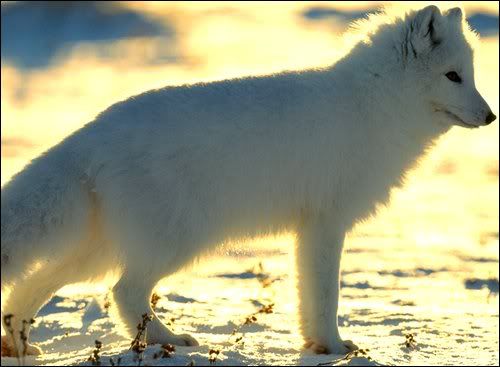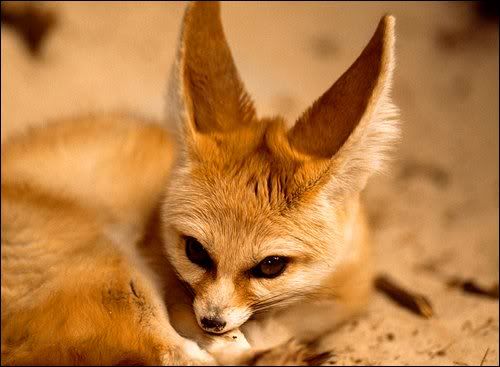|
|
Fox
Apr 14, 2009 19:07:07 GMT -5
Post by Revenge on Apr 14, 2009 19:07:07 GMT -5
Foxes
Fabulous Foxes: Foxes belong to the canid family and include such species as red fox, kit fox, swift fox, fennec fox, arctic fox and gray fox, just to name a few. While some species of canid have been hunted almost to extinction because of their penchant for livestock and the depletion of their natural habitats, some species of fox such as the red fox have adapted well to changing times and find great opportunities for food and shelter in urban environments. The red fox is not a finicky eater, and will ingest beetles, worms, frogs, birds, eggs, mice, fruits and refuse.
Similar Characteristics: All species of foxes have similar characteristics. They tend to be light brown, reddish, gray or dark brown in color, except for the arctic fox, which is pure white in winter. Most foxes have relatively large ears that stand up straight and long bushy tails. Home for most foxes is a den tucked away among rock crevices, an abandoned rabbit burrow or a tree hole in the case of the gray fox.
DID YOU KNOW?
Fox Names: A pack of foxes is called a "skulk." A fox's bushy tail is called a "brush." And its acute muzzle is called a "fox face."
On the Brink: Some fox species, such as the red fox, are highly adaptive. Others, like the crab-eating fox of South America and the bat-eared fox of Africa, are on the brink of extinction in their native habitats.
Cold-Adapted Fox: The arctic fox has several adaptions to its cold environment, including thick, white fur, a good supply of body fat and a system of blood circulation in its paws that keep them constantly warm. |
|
|
|
Fox
Apr 14, 2009 19:20:41 GMT -5
Post by Revenge on Apr 14, 2009 19:20:41 GMT -5
The Arctic Fox
Arctic Fox Profile
The arctic fox is an incredibly hardy animal that can survive frigid Arctic temperatures as low as –58°F (-50°C) in the treeless lands where it makes its home. It has furry soles, short ears, and a short muzzle—all-important adaptations to the chilly clime. Arctic foxes live in burrows, and in a blizzard they may tunnel into the snow to create shelter.
Arctic foxes have beautiful white (sometimes blue-gray) coats that act as very effective winter camouflage. The natural hues allow the animal to blend into the tundra's ubiquitous snow and ice. When the seasons change, the fox's coat turns as well, adopting a brown or gray appearance that provides cover among the summer tundra's rocks and plants.
These colorings help foxes to effectively hunt rodents, birds, and even fish. But in winter prey can be scarce on the ground. At such times, arctic foxes will follow the region's premier predator—a polar bear—to eat the leftover scraps from its kills. Foxes will also eat vegetables when they are available.
Like a cat's, this fox's thick tail aids its balance. But for an arctic fox the tail (or "brush") is especially useful as warm cover in cold weather.
Female arctic foxes give birth each spring to a large litter of up to 14 pups.
Arctic Fox Range (In the yellow)
Fast Facts
Type: Mammal
Diet: Omnivore
Average lifespan in the wild: 3 to 6 years
Size: Head and body, 18 to 26.75 in (46 to 68 cm); Tail, up to 13.75 in (35 cm)
Weight: 6.5 to 17 lbs (3 to 8 kg)
Group name: Skulk or leash
Size relative to a 6-ft (2-m) man
|
|
|
|
Fox
Apr 14, 2009 19:24:53 GMT -5
Post by Revenge on Apr 14, 2009 19:24:53 GMT -5
The Fennec Fox
Fennec Fox Profile
The fennec fox is the smallest of all the world's foxes, but its large ears, measuring 6 inches (15 centimeters), appear to be on loan from a bigger relative.
Fennec foxes dwell in the sandy Sahara Desert and elsewhere in North Africa. Their nocturnal habits help them deal with the searing heat of the desert environment, and some physical adaptations help as well.
Their distinctive, batlike ears radiate body heat and help keep the foxes cool. They also have long, thick hair that insulates them during cold nights and protects them from hot sun during the day. Even the fox's feet are hairy, which helps them perform like snowshoes and protects them from extremely hot sand. The fox's feet are also effective shovels for frequent digging—fennec foxes live in underground dens.
These foxes dwell in small communities, each inhabited by perhaps ten individuals. Like other canids, male fennecs mark their territory with urine and become aggressive competitors when mating season arrives each year.
Fennec foxes are opportunistic eaters. They forage for plants but also eat rodents, eggs, reptiles, and insects. Like most desert dwellers, the fennec fox has developed the ability to go for long periods without water.
These foxes are cream-colored with black-tipped tails. Their adorable appearance makes them favorites of the captive pet trade, and local peoples also hunt the fennec fox for its fur. Little is known about the status of wild fennec fox populations.
Fennec Fox Range (In the yellow)
Fast Facts
Type: Mammal
Diet: Omnivore
Size: Head and body, 9.5 to 16 in (24 to 41 cm); Tail 7 to 12.2 in (18 to 31 cm)
Weight: 2.2 to 3.3 lbs (1 to 1.5 kg)
Size relative to a 6-ft (2-m) man
|
|
|
|
Fox
Apr 14, 2009 19:25:39 GMT -5
Post by Revenge on Apr 14, 2009 19:25:39 GMT -5
The Red Fox
Red Fox Profile
Red foxes live around the world in many diverse habitats including forests, grasslands, mountains, and deserts. They also adapt well to human environments such as farms, suburban areas, and even large communities. The red fox's resourcefulness has earned it a legendary reputation for intelligence and cunning.
Red foxes are solitary hunters who feed on rodents, rabbits, birds, and other small game—but their diet can be as flexible as their home habitat. Foxes will eat fruit and vegetables, fish, frogs, and even worms. If living among humans, foxes will opportunistically dine on garbage and pet food.
Like a cat's, the fox's thick tail aids its balance, but it has other uses as well. A fox uses its tail (or "brush") as a warm cover in cold weather and as a signal flag to communicate with other foxes.
Foxes also signal each other by making scent posts—urinating on trees or rocks to announce their presence.
In winter, foxes meet to mate. The vixen (female) typically gives birth to a litter of 2 to 12 pups. At birth, red foxes are actually brown or gray. A new red coat usually grows in by the end of the first month, but some red foxes are golden, reddish-brown, silver, or even black. Both parents care for their young through the summer before they are able to strike out on their own in the fall.
Red foxes are hunted for sport, though not extensively, and are sometimes killed as destructive pests or frequent carriers of rabies.
Red Fox range (In the yellow)
Fast Facts
Type: Mammal
Diet: Omnivore
Average lifespan in the wild: 2 to 4 years
Size: Head and body, 18 to 33.75 in (46 to 86 cm); Tail, 12 to 21.75 in (30.5 to 55.5 cm)
Weight: 6.5 to 24 lbs (3 to 11 kg)
Size relative to a 6-ft (2-m) man
|
|
|
|
Fox
Apr 14, 2009 19:26:31 GMT -5
Post by Revenge on Apr 14, 2009 19:26:31 GMT -5
|
|











